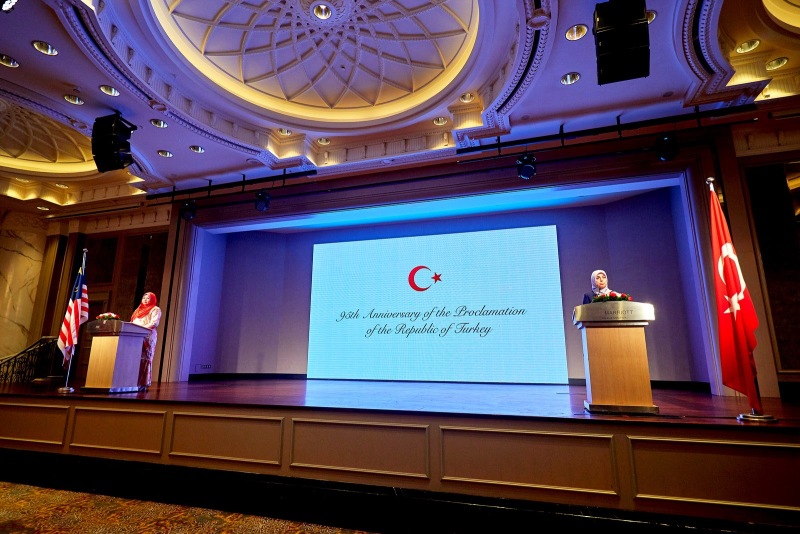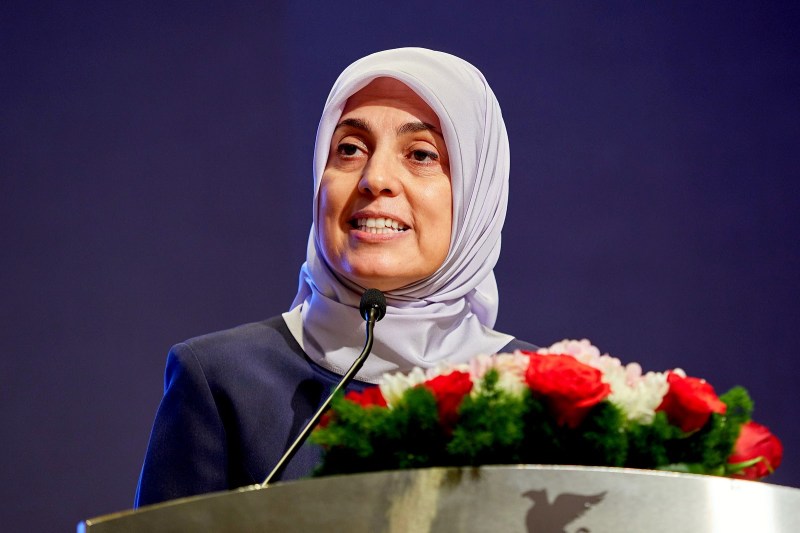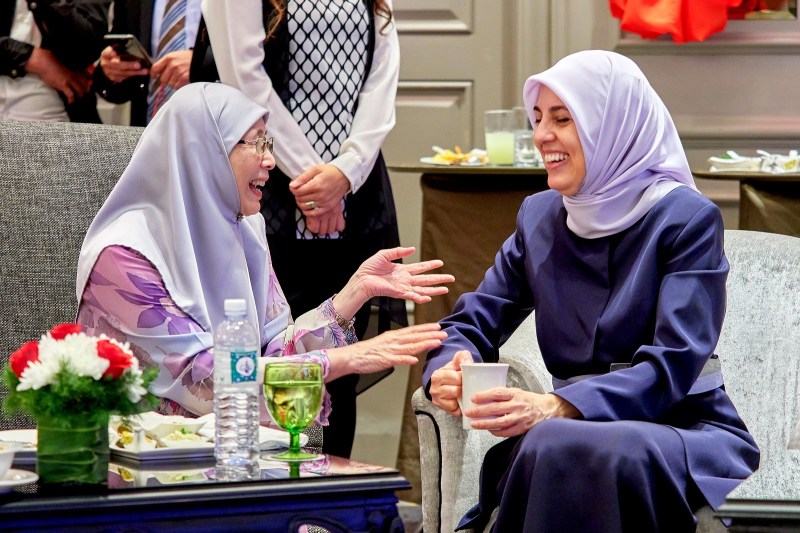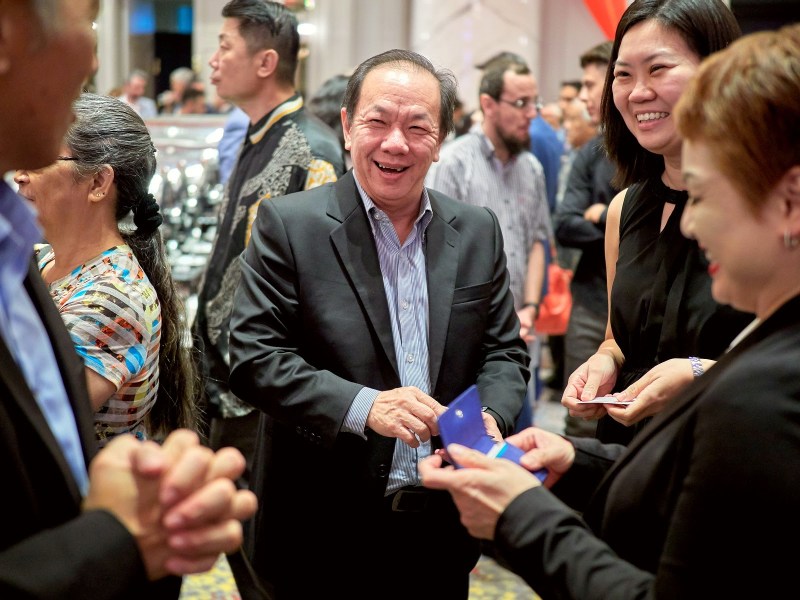A large portion of my work as a commercial photographer is event coverage. I have covered events ranging from a private birthday party to a large corporate event with almost a thousand attendees. There are no hard and fast rules when it comes to event photography but I have learned so much from my experience and I would like to share some of these tips today. A lot of these discussions revolve more around your attitude and approach as a photographer than the actual technical execution. I shall focus on how to minimize mistakes and be as prepared as you possibly can for any unexpected developments.
All the images in this article were shot during the Turkish National Day 2018 celebration at the JW Marriott Hotel, Kuala Lumpur. I was hired by the Turkish Embassy to shoot the event and I’ve reproduced these photographs with special permission from the Embassy. The Deputy Prime Minister of Malaysia, Datuk Seri Wan Azizah was the VVIP for the celebration. My main task was to document the event and capture as many moments of interactions between the Turkish Ambassador, Ms. Merve Kavakci and her guests at the celebratory dinner. It was a beautiful celebration with a joyous and festive mood, accompanied by a scrumptious buffet full of traditional Turkish food.
The job of an event photographer starts much before the actual day of the event. My homework includes finding out all the important details pertaining to the event and the specifics of my shotlist. I’m in constant contact and have at least one meeting with my client so that we can both understand each other better. I am careful not to overpromise and ensure that I am able to deliver my end of the bargain. It is also important to highlight any challenges or difficulties so that the client is fully aware of the situation and can also provide help when necessary. Locking down expectations at the beginning is crucial to ensure there are no surprises and I know what to focus on during the actual event.
For the day of the shoot, I dress up according to the mood or theme of the event. For example, I was shooting a company annual dinner recently that had a “traditional” costume theme – so I went in a Baju Melayu (Traditional Malay outfit for men). As a rule of thumb, it is always better to be overdressed. When covering corporate events as well as prestigious celebrations like the Turkish National Day shown here, I stick to formal wear (including a blazer or dinner jacket) to blend into the crowd. It is important to not only show my best but also blend in to my surroundings. This helps me command better respect from the audience and ensure I can work efficiently.
Do not show up just in time for the start of the event, always show up early. If my client asks me to be there by 6.30pm, I will make sure I am 15 minutes early as this allows me to do one final recce and touch base with my client about any important updates or changes to the program. One of the worst things that could happen is you being late and missing a key moment in the event.
When the shoot starts, maintaining a positive and friendly attitude is necessary throughout. If I want people to smile and look happy in my shots, I have to first initiate that expression. The client will be more confident and happy to work with a friendly and personable photographer in comparison to a stressful, chaotic and grumpy looking one. Even if I screw up a shot or something unexpected and bad happens, I will brave a poker face. Being positive and respectful will go a long way in your success as an event photographer.
I will not comment too much on the technical execution since everyone adopts their own unique shooting approach. However, I must emphasize that for events, the moment matters more than technical perfection. Shooting a fast paced event requires fast reflexes and lightning quick camera operating efficiency. At times to successfully capture something that happens so suddenly, I will need to compromise a technical detail. The obsession of constantly tweaking your camera settings or worrying about dynamic range and high ISO noise will get you into trouble. These are the things that I least worry about while on the job. Instead I focus on the important moments and do everything in my power to capture those moments as beautifully as I can. That means shoot at high ISO if I need to, and stop worrying about blown highlights or nailing perfect exposure.
Another important point to note is that you will not be able to shoot everything, you will miss some shots. If there is a choice, then prioritize what matters more to the client. It is foolish to try to cover everything, but it is also crucial to ensure all the specific tasks and goals assigned during the client-photographer meeting are accomplished. My point is, you will be able to get the shots that the clients wants if you stay focused on the goal, rather than spraying and praying all night long.
During the event, I am constantly moving around so I can effectively vary my composition options. I will also use different focal lengths to shoot all possible combinations of coverage, ranging from ultra wide to include the background, medium telephoto to exclude some unwanted mess as well as super tight telephoto end to zoom right into specific subjects to isolate them. To illustrate this, are a series of photos above of Ambassador Merve giving her official speech on stage. The first shot is an overall view of the wide stage with the projection and a Malaysian minister at the far end of the stage, the next shows only her and the Turkish flag besides here, and finally a tight, head and shoulder shot focusing on her facial expression during her speech delivery. The client appreciated the variety of angles and framing in the final delivery.
When shooting casual and candid shots of people, I have a few rules that I always observe. I will target dramatic moments with hand gestures and facial expressions. There is no point shooting people standing about doing nothing. Similarly, when shooting someone giving a talk, I always ensure the person is not looking down at their notes. The look in their eyes and the expression on their faces, whether playful or serious, can give good results.
For this particular event, I was shooting with one camera body, the Olympus OM-D E-M1 Mark II and several M.Zuiko lenses. I used the M.Zuiko 7-14mm F2.8 PRO wide angle lens only for large group shots, shooting in extremely tight spots as well as environmental coverage of the hall. About 90% of my images were shot with either a 25mm F1.2 PRO lens or a 45mm F1.8 lens, as I needed the fast aperture of the prime lenses to shoot in less than ideal lighting conditions. The large aperture also provided me shallow depth of field rendering to isolate my subjects. Finally, I used the 40-150mm F2.8 PRO telephoto lens for most of my stage shots, especially the official speeches.
Much like Ming Thein, I can be a little paranoid when packing equipment for jobs. I have a backup Olympus OM-D E-M1 (original) stored in the bag at all times, just in case. I also have a backup lens, the M.Zuiko 12-40mm F2.8 PRO lens, which is a versatile backup to any of the other lenses (except the telephoto). I also brought along an external flash which I decided not to use in the end. I wanted to be less intrusive and not fire an annoying flash every so often into the face of the Ambassador of Turkey for the whole night.
I was shooting wide open in Aperture Priority and adjusted ISO as necessary to ensure sufficient shutter speed (keeping it at 1/100 sec or faster). My ISO ranged from 800-1600, and there were only a few instances where I needed to use ISO3200. When it comes to event shoots, you must already be proficient with your exposure basics and camera operations as there is no room for second guessing. Every little moment spent hesitating will cost you shots. If you still wonder what lens works best and are not sure if you should be using Shutter, Aperture or Manual, then do yourself a favor and avoid accepting the responsibility of covering such an important event. At least until you’ve had more practice and experience with the camera.
I find that it helps if I can provide quick edits of select images for my client on the same day of the shoot. Therefore, being efficient in post-processing helps a lot. I believe in minimal post-processing but shoot everything in RAW for versatility in color correction and exposure tweaks. I never surrender straight out of camera JPEG files to my client. I negotiate time for post-processing and submission, even for the quick initial edits. I am the photographer and responsible for showing only the best of my work.
I hope that these tips were useful and help those who want to pick up event photography. At the end of the day, you must ensure you present yourself positively at all times and do what you can to capture the shots that your client wants. I have always enjoyed shooting events and being able to document joyous occasions.
If you are an event photographer and you have more tips to share, I would love to hear them in the comments!
__________________
We are also on Facebook and there is a curated reader Flickr pool.
Images and content copyright Robin Wong 2018 onwards. All rights reserved




















Hi Rabin’s, Awesome tips here. Working as a professional event and party photographer in Australia, i find it extremely important to stay on the top of the industry price and budgeting when it comes to quoting to your clients. Absolutely recon the point by Robins. Thanks again, good stuff!
Picture shots are good and the way you have explained everything in detail is helpful for photography learners.
Hello Robin Wong,
Thanks for share great information about event photography. I read this blog and also searching on many websites regarding this information. But your comment gives me complete details about photography. Please post more blog to other services related.
Hi Robin, great pics! I’d like to ask how you varied your lenses. Do you keep one on and shoot enough before you change, or do you walk around, eye a shot and change lenses to make sure you have the correct one on? Just curious, cos the second approach feels like a lot of lens changes!
Great article. I shoot a fair number of events and you are right on a lot of things.
I have to say that the Olympus is possibly the best event camera one can use. The small size allows ease of use for hours on end. The lenses (especially the 12-100) are brilliant. And the AF allows tack sharp images in even mediocre light.
The exposure simulation is enormously helpful as one can get very close to perfect exposure. A fact very important for spotlighted speakers on stage.
In many events, I shoot in a small meeting room with a lot of VIPs. Silent shutter is critical as with using my old Canons they would kick me out after 25 exposures. With silent shutter I can get around 600 images before I get tired of the job.
Useful suggestions for events. Being in a light happy mood is easy to forget if I’m working hard to get the shot – thanks for the reminder. I completely agree about the importance of ‘the moment’ when something interesting is happening. Focus and composition are kind of useless if the shot is boring.
I am very impressed with your white balance, it is very accurate in such a wide variety of settings. I’d like to know if you shoot Kelvin or fix your RAW files in post?
I shot everything in RAW, and White Balance was left at Auto in camera. Most of the time the camera got it right, but I do adjust the White Balance and colors in Post-Processing stage when necessary.
I did some of that in the bad old days. 2- Nikon F2 bodies and 24mm f/2.8, 85mm f/1.8 all shot on Kodachrome 64 with a blue correction filter on each lens! My client wanted to use the shots for slide shows. I ended up shooting at 1/30 sec. wide open. I had to time the shot so the guests were relatively still. It’s so easy now that most amateurs with very little experience can do an OK job.
As much convenience the newer camera brings, I think shooting discipline is still crucial! MT has described it best.
Hi Robin,
I shoot a lot of events, meetings, and political demonstrations both indoors and out and at night as well. The one thing I noticed right away is that you seemed to have excellent lighting in the venue for the most part (or your post processing skills are great for making up a deficit of lighting). I often run into low light situations and, for a variety of reasons, can’t use a flash. I’m just wondering if you’d comment on how you handle no flash, low lighting situations. Using a couple of OMD EM-5IIs and the 12-40mm, 2.8 and the 75 mm, 1.8 lenses for the most part.
In this particular case, I was using Olympus M.Zuiko 25mm F1.2 for most of my shots, hence the F1.2 really helped in preventing the use of overly high ISO numbers. I generally find using 25mm F1.8 and 45mm F1.8 (long time usage) sufficient for even very dim locations, shooting wide open of course. And yes, the F2.8 may suffer, but I would not hesitate to use the flash when necessary!
To, Word Press Respected Madam/Sir, Best greetings!
I will often use both of my cameras (an E-M1.2 and an E-M1). The E-M1 has completely satisfactory image quality, and that way I can have both the 17/1.8 and 45/1.8 mounted and ready to go. The controls are similar enough that switching back and forth is easy. If I find one lens is getting more action, I’ll ensure it’s on the E-M1.2. I find using belt holsters like the Spider series convenient for keeping them accessable all the time and not swinging around on straps. Extra cards, batteries and any other lenses can go in a small shoulder bag or even pockets.
I have tried using the two camera approach and it did not work out very well for me. But I understand the convenience and also the flexibility of this setup!
Well done, Robin, you did an excellent job!
Thanks Felix!
Brilliant article Robin, I will save as a road map should ever I get asked to cover an event.
Thanks, glad you have found the tips useful!
Nice work, getting everyone to cooperate for the closing group shot is impressive!
It is important to communicate and work with the subjects you shoot!
Awesome tips! Thanks for sharing!
Thanks, my pleasure to share!